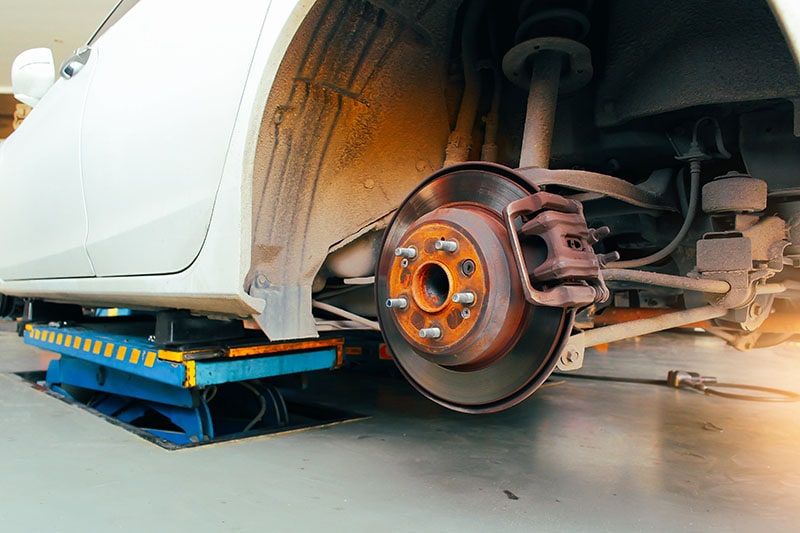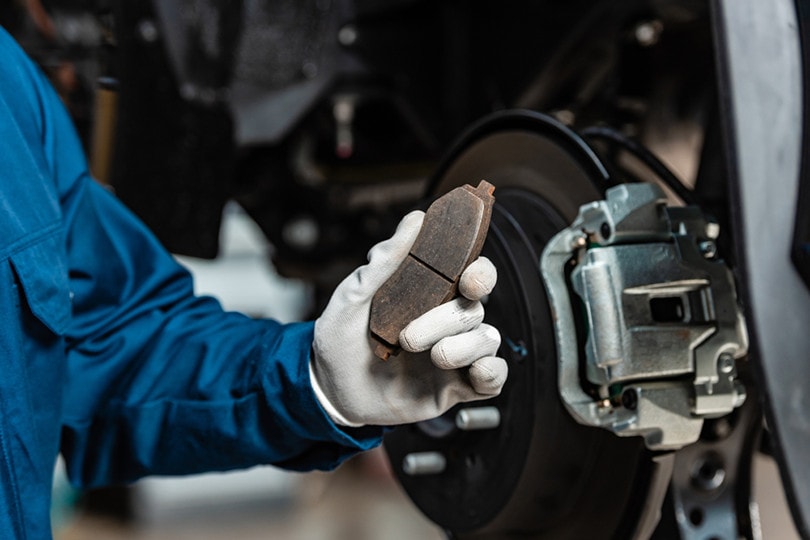How Often Should You Change Brake Pads? Tips, Signs & FAQs
-
Shea Cummings
- Last updated:

All the incredible new safety technology on vehicles today is wonderful, but the most important piece of safety equipment on a vehicle is still the brakes. What good will a collision alert do if you can’t stop?
So, keeping your brakes in good working condition is essential. One of the main wear items on the brakes is the pads. On average, you can expect to replace the brake pads every 10,000 to 20,000 miles (16,000 to 32,000 kilometers).
Of course, some variables play into how often you need to do maintenance on your brakes. In this article, we will discuss some of the contributing factors to needing a pad replacement and several warning signs that your brakes are going to need fixing soon.
Tips for Saving Your Brakes
We use the brakes constantly while driving, so it’s inevitable that they will wear out. However, there are things that we can do to help prolong their lives as much as possible.
- Gear down: Instead of applying brake pressure to slow your vehicle while going downhill, if possible, gear down. Not only can this keep you at a much steadier speed, but it helps cut down on brake pad wear.
- Smooth braking: If you follow vehicles closely, it often requires heavy braking. This heavy braking wears down your brake pads much quicker than they should.
- Slow down: Your pads will wear out quickly if you’re driving at high speeds and braking at these speeds. Allowing yourself to slow down naturally or gearing down will take some pressure off the brake pads.
- Lighten the load: Adding a lot of weight to your vehicle can contribute to more wear and tear on the brake pads. By lightening the load, you can lengthen your brake pad’s life.

Warning Signs of Needing New Brakes
Your vehicle’s brake pads will eventually wear out no matter what you do. If you allow them to wear down to the metal without changing them, the metal will destroy your rotors, and it will be a much more expensive fix.
However, if you take heed to the warning signs that your brakes are wearing out, you can save yourself a significant amount of money by not having to replace your rotors. Here are several things that point towards brake pads wearing out.
- Squeaking, squealing, or grinding: As the brake pad material begins to wear out, the pads will make noises. The squeaking and squealing sounds are what they are designed to do as an early warning. If they start to grind, the pad may be worn-out and scraping directly on the rotor, which is not good and needs addressing ASAP.
- Vibration: If your brake rotors are warped, it can cause uneven wear on the pads. Once this happens, you’ll often notice a vibration or shake in the vehicle when applying brake pressure.
- Longer stop time: As the pads begin to wear out, your stop time significantly increases. You’ll notice that you must put much more pressure on the brake pedal to actually bring your vehicle to a stop. This could also be a sign of low brake fluid, which could be a leak in your brake system.
- Indicator light: Many new vehicles have advanced brake warning systems. If your vehicle has a sensor that measures pad life and the indicator comes on, it’s a good idea to get that checked right away.
- Thinning pad: It’s a relatively easy process to check brake pads on most vehicles, and it usually doesn’t require taking anything apart. If you’re able to see the pads on your vehicle, you’ll be able to tell approximately how much life you have left.
FAQ: Changing Brake Pads
Can I change my brakes myself?
Changing brake pads is not hard. Even a beginner DIYer can manage it after watching some YouTube tutorials. That being said, your brakes are a critical safety component, so if you’re not 100% confident or more than pads need changing, it may be a good idea to take your car to a reputable shop.

Do some brake pads last longer than others?
There are three main types of brake pads: organic, semi-metallic, and ceramic. Organic is usually an economy brake pad that emphasizes affordability, whereas ceramic brake pads are typically in luxury cars and have the smoothest braking and longest life.
One of the most common pads that offer the best balance of affordability and durability is semi-metallic.
Do I have to replace rotors with pads?
You won’t usually have to replace rotors with pads. As a rule, you will also replace rotors for every second or third set of pads. However, if you let your pads wear down too much, it could destroy your rotors, in which case you’ll be replacing rotors with the pads.
 Conclusion
Conclusion
Brake maintenance isn’t something you want to put off. Under normal conditions, your brakes will last for a reasonable amount of time, so you shouldn’t have to replace them often. However, if you are 10–20 thousand miles since your last pad replacement and any of the above warning signs start happening, it’s a good idea to get that checked out right away.
Related Read :
- How Long Do Brake Pads Last? What Factors Affect Longevity?
- HOW LONG DOES IT TAKE TO CHANGE BRAKE PADS?
- https://www.harrtoyota.com/how-often-should-you-replace-brake-pads-and-rotors-worcester-ma/
- https://nubrakes.com/blog/6-signs-its-time-to-replace-brake-pads/
- https://www.mydriversedge.com/6-mistakes-that-wear-out-brake-pads-prematurely/
- https://www.repairsmith.com/i/blog/how-long-do-brake-pads-last/
Featured Image Credit: BLKstudio, Shutterstock
Contents
